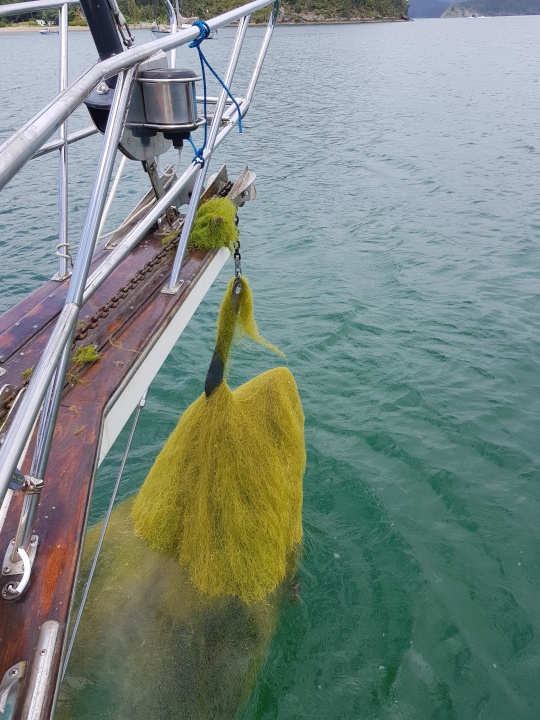Molecular analysis says seaweed not ‘mermaid hair’
Molecular analysis says seaweed not ‘mermaid hair’.
Molecular analysis has confirmed an unusual seaweed hauled up on an anchor in the Bay of Islands late last year is not the potentially invasive ‘mermaid’s hair’.

Relieved
Northland Regional Council (NRC) biosecurity experts say the
test result was delivered recently by molecular scientists
under the direction of the Ministry for Primary
Industries.
Sophia Clark, the council’s Biosecurity Manager – Marine & Strategy, says while the mystery find has turned out to be the non-invasive Chaetomorpha linum, authorities were nonetheless thrilled it had been reported.
“It’s still an unusual looking seaweed and we’re really pleased the incident reporter took the time to let both us and the Ministries of Primary Industries (MPI) know.”
Ms Clark says in recent months the council has noticed an increase in members of the public reporting things they believe are unusual or could be a known marine pest.
“The seaweed that’s just been tested was hauled up on a boat anchor in waters off Roberton Island late last year.”
She says making a formal, positive identification of some marine pest species can be a reasonably lengthy, time-consuming and difficult process; for instance, the DNA of the suspected mermaid hair specimen had to be compared to other samples, one of which had to be sent from Australia.
While in this case the discovery had turned out to be a false alarm, Ms Clark says officials are thrilled it was reported and thanked the member of the public responsible.
“Marine pests have the potential to cause a great deal of environmental, economic and other harm across multiple fronts, so any reports that draw them to our attention are extremely helpful, even if it ends up being a false alarm.”
Ms Clark says as part of its work to monitor and prevent the spread of pests into new areas, council divers had inspected more than 1250 boat hulls in Northland over summer.
To date, those inspections had not revealed any new established marine pest populations outside of the areas the pests were already known to live in. (This included Mediterranean fanworm, which is only found in Whangarei Harbour.)
“However, with more than 3200km of coastline and a vast marine space on our doorstep in Northland, it’s impossible for us to be everywhere at once and it’s great to have eyes and ears out on the water via the public to help protect our precious marine space.”
Ms Clark says while mermaid’s hair is not the worst marine invader potentially threatening Northland, its presence in our waters would still be an issue as it is a biofouling organism.
“It can attach itself to boats and marine structures and relatively quickly build up in both mass and area, effectively pushing out native species like the green lipped mussel.”
She says unwanted seaweeds are just one of many potential marine invaders and information on these and land-based pests is available online via www.nrc.govt.nz/pestcontrolhub
“It’s really important to make sure you keep your hull and other boating equipment clean and if you do pull up biomass on your anchor, make sure you don’t transport it to your next destination.”
“Remember; if it looks unusual, keep the sample on board and call the regional on (0800) 002 004 or the Ministry for Primary Industries’ 24/7 exotic pests and disease hotline on (0800) 809 966.”
ENDS


 Gordon Campbell: On The Government’s Stubborn Refusal To Invest For Growth
Gordon Campbell: On The Government’s Stubborn Refusal To Invest For Growth Kick Back: Urgent Review Of MSD Needed To Prevent More Rangatahi Sleeping Rough
Kick Back: Urgent Review Of MSD Needed To Prevent More Rangatahi Sleeping Rough Te Pūtahitanga o Te Waipounamu: Government Hellbent On Ignoring Evidence On Impact Of Social Investment For Most Vulnerable Whānau
Te Pūtahitanga o Te Waipounamu: Government Hellbent On Ignoring Evidence On Impact Of Social Investment For Most Vulnerable Whānau Rangahau Aotearoa Research NZ: One In Two New Zealanders Are Affected By The Cost Of Living Crisis
Rangahau Aotearoa Research NZ: One In Two New Zealanders Are Affected By The Cost Of Living Crisis Greenpeace: Greenpeace Seamounts Expedition Sets Off To Uncover Secrets Of The Deep
Greenpeace: Greenpeace Seamounts Expedition Sets Off To Uncover Secrets Of The Deep Free Speech Union: Trust In Media Plummets Further - New Polling Shows Centralised Regulation Will Not Help
Free Speech Union: Trust In Media Plummets Further - New Polling Shows Centralised Regulation Will Not Help FIRST Union: Veterinary Nurses File Historic Pay Equity Claim On International Working Women’s Day
FIRST Union: Veterinary Nurses File Historic Pay Equity Claim On International Working Women’s Day


